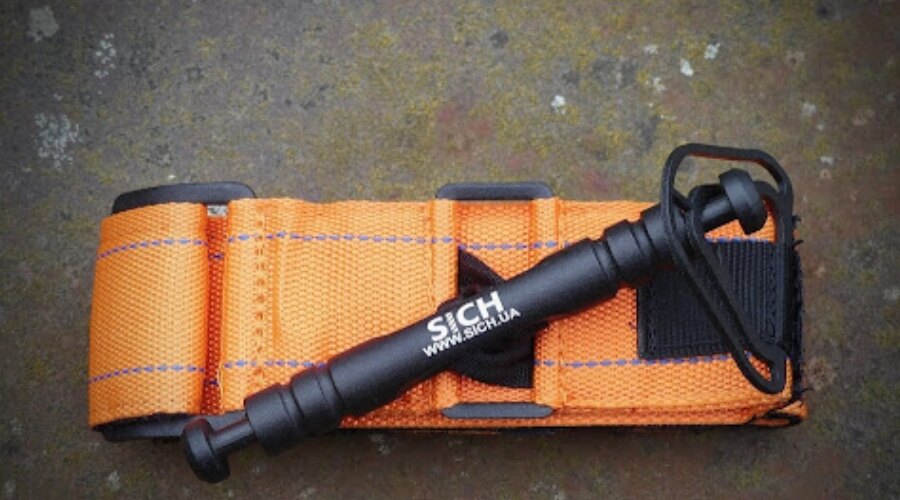Everything you need to know about tourniquets
Tourniquets. Rescue aids that should be part of every first aid kit and can save a life in certain situations. Bleeding is one of the most common causes of death after injuries. What should you know about tourniquets and why should you have at least one in your first aid kit—or in the back of your car?
Tourniquets and their effects have been known for centuries, but until recently, humanity seems to have overlooked these aids. This changed only in the last 20 years or so, when terrorist attacks began to multiply around the world, which once again stirred up the discussion about the effective protection and rescue of the seriously injured.

The SICH Tourniquet, a reinforced individual combat tourniquet, has a sophisticated technology that allows simple and very effective use.
Being in the severely injured column not only after an attack, but also after any accident or natural disaster, still offers a certain percentage of hope. And the effort of all rescuers, both professional and civilian, is to move the statistics of victims from the "severely injured" column to the "dead" column as little as possible.
When the tourniquet is used
A tourniquet may seem like too invasive an intervention into the injured person's body, but sometimes there is simply no other way. Especially in cases of massive bleeding. Regardless of whether blood flows from the wounded person in a stream or sprays from it. It can also be used in limb amputations. To sum it up a bit cynically: you can live without a hand, but not without blood.
First, try to stop the bleeding in another way, ideally with a pressure bandage. If you don't have a pressure bandage available on site (for example, even in the area of car first aid kits, this is rather an exceptional content), try pressing on the injured area with your fingers—in your own interest, only after putting on sterile gloves.

The minimum width of the tourniquet is 40-50 mm. Anything thinner substantially increases the risk of secondary complications.
If you have a pressure bandage, but the injured person's blood will seep through it three times (that is, it will seep through three of its layers), then it is advisable to use a tourniquet. Earlier in children—children are smaller, have a smaller amount of blood in circulation and therefore can bleed out much earlier than adults with a comparable blood loss.
In some cases, however, it is appropriate (or even necessary) to use the tourniquet immediately. And this in the case of a higher extent of injury (the use of a pressure bandage would be ineffective) or in case of a complete amputation of an arm or leg. You will also use it in moments when you need to quickly take care of a larger number of injured people.
You can also use the tourniquet in combat conditions, where there is no time to think about the potentially negative consequences of its use, and at the same time there is relatively little time to stabilize the injured. In such situations, the tourniquet has another great advantage—it can often be used with only one hand, so you can apply it to yourself, of course, provided you remain conscious.
Wrong substitutes
It is really advisable not to improvise and not to use substitutes when saving lives by stopping arterial bleeding. For example, the old rubber tourniquets are out of date. They strangle the limb "perfectly" and may save the injured person's life, but their leg or arm will have to be (unnecessarily) amputated. This refers to the various strings, ropes and shoelaces that, for example, are "lying" around in traffic accidents, and you would like to use them with good intentions. In such situations, really think twice.
Under no circumstances should you use paracord as a tourniquet, even though various articles appear on the Internet here and there that approve and even recommend the use of paracord to stifle arterial bleeding. In short, the choke should not be thinner than 40-50 mm. The thinner the tourniquet, the more painful it is for the injured person to use, and the more likely the use of the tourniquet will lead to other secondary injuries.
Removing the tourniquet
We should also mention the topic of removing the tourniquet. If you have already applied the tourniquet to the injured person once, you should wait for the professional elements of the paramedics, or rather the doctor, to remove it. The reason is that fresh blood cleanses the limb of metabolic waste products. After a few hours, the unchanged blood in the limb will be toxic—and we definitely don't want to get that kind of blood into the rest of the body.

You can also apply the tourniquet with one hand. Practice this "trick" in advance.
Massive blood poisoning could lead to fatal consequences for the injured. So forget what you may have been taught in first aid at school or in the military. Just write down the date and time when the tourniquet was applied (some tourniquets have a marker as an accessory, with which you can do so), and the tourniquet will be removed by professionals in the hospital, possibly with the replacement of part of the blood in the body. But doctors and health professionals will know this better than you…
How the tourniquet should look like
The tourniquet should be as wide as possible—ideally at least 50 mm wide. The wider the tourniquet, the less painful its application will be for the injured. In addition, the wider the tourniquet, the less likely it is that you will cause further complications with your efforts to provide first aid to the injured, even with permanent consequences. Using a tourniquet can save life, but often at the cost of damaging muscles, nerves or blood vessels.
You may know the choke from situations where the nurse takes your blood at the doctor's or inserts an intravenous cannula. But such a tourniquet is quite unsuitable for use in first aid—it is mainly suitable for stopping venous bleeding, not arterial bleeding.
On the contrary, a tactical army tourniquet—which can also be used in the civilian area—is made up of a strip of fabric with a width of at least 50 mm, and there is always a tightening/twisting and clamping part on it. And also the area mentioned above, where you write the date and time of tourniquet application.
With tourniquets, as with other medical devices, it is very important to pay attention to their origin —there are often "fake" pieces on the market that can endanger the injured person's life instead of helping them. Fakes tend to be lighter, they are sewn even where the originals have welded seams, and in addition, they do not use such high-quality plastics, which can lead to their cracking under stress—at the moment when the tourniquet should 100% fulfill its first and only function.
Suitable substitutes
We have already said something about inappropriate tourniquet substitutes, but there are also suitable substitutes that we can use in a real emergency without doing anything wrong. To retract the limb, use any piece of fabric that is wider than 50mm and ideally stretchable. It can be, for example, different scarves, sweatpants, leggings, t-shirts, jackets... then use a stick, writing pen or even a baton as a pull-down part—in short, any suitable thing with an elongated shape that happens to be at hand at that moment.
Tourniquets in our offer
But why put up with substitutes, when you can equip yourself preventively and fully professionally. Here at Rigad, we only offer original tourniquets of various brands. Do not look for fakes with us.

The Black Front tourniquet stands out for its small dimensions and compactness.
Perhaps the most classic model in our range is Composite Resources' Combat Application Tourniquet (C-A-T), a tourniquet that is an obvious choice for first responders, even though it was primarily developed for combat application.
Another model is the innovative SICH Tourniquet, a Ukrainian invention the name of which derives from the Ukrainian symbol for strength. This is the first basic model of the brand—because of it, the brand itself was created in the first place.
Another tourniquet comes from the Polish manufacturer of rescue equipment Black Front. It is possible not only to stop bleeding with it, but also to bandage less serious wounds with quality instead of a classic bandage. And finally, we have the certified S.B.T. (Stop Bleeding Tourniquet) from the Czech company Skala Medica. The S.B.T. tourniquet was developed without the use of velcro, which, although functional, is not so resistant to dirt and water.
For training purposes, the tourniquets from our range can also be perfectly complemented by the products of a Georgian brand, TactiFlesh, namely hyper-realistic simulators of devastating injuries, or arrests of various types of bleeding. Not only as rescuers, but also as laymen, you can effectively practice saving lives on them.
Readers are further interested












































































































































